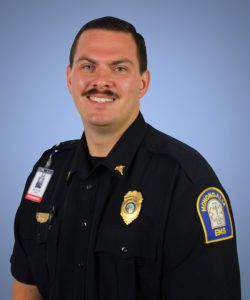
Despite its well-established grip in Appalachia, the West Virginia opioid epidemic hasn’t always looked the same. The crisis has changed, ebbed, and flowed to reveal new challenges along the way.
It’s a familiar pattern, according to 29-year-old Paramedic, Nathan Weese, who describes opioid-related emergencies as arriving in “waves”. Public health experts echo his theory, crediting the epidemic’s first wave to over-prescribed opioids in the mid-1990s, followed by another wave of heroin-related cases years later (1).
Now, emergency medical teams are noticing another wave sweep its way across the state. This time synthetic opioids, such as fentanyl, are advancing its course. And according to Weese, many patients don’t realize they’re using it until it’s too late.
“A small amount [of fentanyl] can be added to other drugs to increase potency,” says Weese. “And when the user is unaware of its presence, the dose that they typically use can prove fatal.”
Fentanyl—A Different Class of Opioid
From May 2020 to April 2021, more than 100,000 Americans died from drug overdose—with more than 60 percent due to synthetic opioids like fentanyl (2).
But what’s so different about fentanyl compared to other potentially dangerous opioids?
“Fentanyl is a highly concentrated form of opioid that is related to other drugs such as morphine and heroin,” says Weese. “It’s often used in medical settings to treat pain or induce sedation, but given in the wrong dose can reduce or eliminate a person’s ability to breathe.”
It’s hard for emergency medical technicians to know just how many overdoses are due to fentanyl. What they do know, however, is that patients rarely use fentanyl intentionally and the substance is often mislabeled as drugs from totally different classes.
For these patients, says Weese, naloxone (medication that reverses opioid overdose) may be the only thing that stands between overdose and death.
“We often respond to people who have admitted to using unrelated drugs, but exhibit symptoms consistent with those of fentanyl ingestion and respond favorably to naloxone,” said Weese. “The likely cause of these situations is that the patient’s usual drug of choice has been contaminated by fentanyl without their knowledge.”
“An Ounce of Prevention is Worth a Pound of Treatment”
When it comes to loosening the epidemic’s grip on the Mountain State, public health officials are beginning to understand the importance of prevention over cure. State organizations like GameChanger are taking this research and applying it to early intervention programs in schools across the state.
“I strongly believe that an ounce of prevention is worth a pound of treatment,” says Weese. “Any organization that is able to effectively reduce the number of West Virginians struggling with substance misuse has the potential to be a great asset to our community.”
Established in 2018,GameChangeraims to prevent drug and alcohol abuse and misuse in the youth population— before it has a chance to start. The organization unites students, educators, and communities across the nation to provide education, training, coaching, and other support services to prevent substance abuse.
In addition to prevention emphasis, Weese also advocates for dismantling the stigma that surrounds opioid addiction. If you’re among the rare, lucky few who haven’t been affected by substance abuse, he encourages compassion and a changed perspective.
“In the case of anyone reading this who has not been affected by substance use, remember that all of us are humans and make mistakes,” says Weese. “Many people feel as if they’re unable to overcome the stigma associated with drug use, regardless of their own current and future actions. As a community, we need to be supportive of any person along their journey to recovery, regardless of their past or current standing.”
About GameChanger
GameChangeris a Student-Powered Substance Misuse Prevention Movement connecting West Virginia students and the educators who care about them with theHazelden Betty Ford Foundationto build school environments that prevent student opioid and other drug use before it starts.
References
- What led to the opioid crisis—and how to fix it. Feldscher, Karen. Harvard T.H. Chan. School of Public Health. 9 February 2022. Accessed from: https://www.hsph.harvard.edu/news/features/what-led-to-the-opioid-crisis-and-how-to-fix-it/
- What is fentanyl and why is it behind the deadly surge in US drug overdoses? Babu, Kavita. UMass Chan Medical School. 10 May 2022. Accessed from: https://www.umassmed.edu/news/news-archives/2022/05/what-is-fentanyl-and-why-is-it-behind-the-deadly-surge-in-us-drug-overdoses/